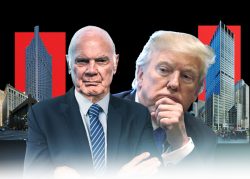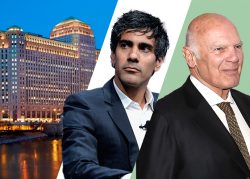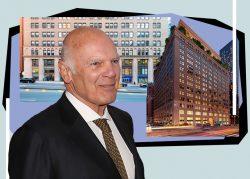When Vornado Realty Trust held its third quarter earnings call in the fall, the outcome of the 2020 presidential election was still up in the air.
In the months since, a lot has happened.
During the company’s fourth quarter earnings call on Wednesday morning, several analysts asked about the company’s plans for 1290 Sixth Avenue in New York and 555 California Street in San Francisco, in which former President Donald Trump owns a 30 percent stake.
“There was a big article, which started all this stuff, in the Wall Street Journal a couple of weeks ago, which I read,” CEO Steven Roth said. “It was an interesting article — much of which was actually news to me.”
The real estate investment trust had put both properties on the market last summer, but suspended those efforts a few months later. This month, the Journal reported that executives had had “internal discussions” about buying out Trump’s stake.
“I was disappointed by the reception of buyers to those assets,” Roth said on Wednesday. “We found that the buyers were in two groups: there were bottom fishers, which were not for us, and the conventional long-term institutional investors were tentative — they couldn’t travel, they couldn’t see the product.”
While everyone on the call managed to avoid referring to Trump by name (one analyst called him “your 30 percent partner”), Roth acknowledged that he was a polarizing figure.
“This is a very interesting and controversial man, who has a lot of people who like him and a lot of people who don’t,” he said, adding that Trump was just a regular businessman when their firms joined forces in 2007. “His role in these buildings is totally passive, and he’s okay with that, and I’m delighted with that.”
And while last month’s Capitol insurrection has exacerbated that polarization, Roth emphasized the quality of the properties themselves, noting that the firm is currently gearing up to refinance 555 California.
“Every American wishes that Jan. 6 hadn’t happened, okay? So obviously that’s not a good thing. Obviously the stuff that happened in the Senate last week is also, you know, same comment,” he said. “Having said that, we have some great buildings, we have great tenants in the buildings, and those assets speak for themselves. Business is business.”
Read more



In fact, the San Francisco building proved to be a bright spot in Vornado’s portfolio in 2020, with same store net operating income rising slightly year-over-year at the property, while falling 13 percent in New York and 30 percent at theMART in Chicago.
“During the period of our 14-year ownership [of 555 California], we have never lost a major tenant at this building,” company president Michael Franco said, calling it “the premier building in the city.”
Overall, the firm recorded a net loss of $209 million for the quarter, or $1.09 per share, compared to net gains of $193 million in the same quarter a year prior.
As in prior quarters since the start of the pandemic, this included a $236 million impairment loss on the company’s prime Manhattan retail. Net income from closings at 220 Central Park South totaled $36 million, compared to $187 million in the third quarter.
On the office leasing front, Vornado executives noted that tenant interest has begun to pick up amid optimism around an impending end to the pandemic, although the glut of sublease space is something to keep an eye on.
The company has also continued to take advantage of favorable capital markets, recently securing a $525 million CMBS refi for One Park Avenue. “This is the best time to finance our product, probably in my career,” Roth said. “And we’re taking advantage of it in a very aggressive but measured way.”
The new administration in Washington, with Democratic control of the Senate and the promise of a new stimulus package, bodes well for the city’s post-pandemic recovery, Roth said. And at the state level, Gov. Andrew Cuomo — whom Roth called “the master builder of our generation” — has plans for Midtown Manhattan that dovetail with Vornado’s own developments around Penn Station.
“We believe in mass, we believe in gathering, we believe in clustering,” Roth said.
